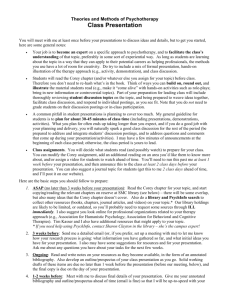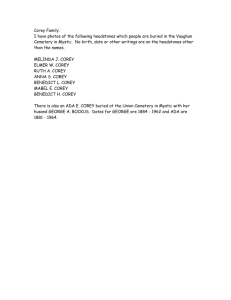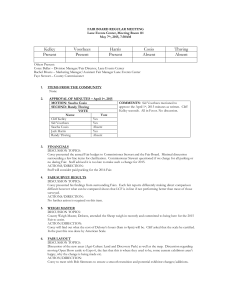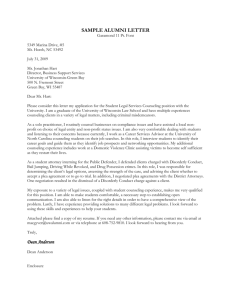REHB 6350 Group Counseling With Addicted Populations
advertisement
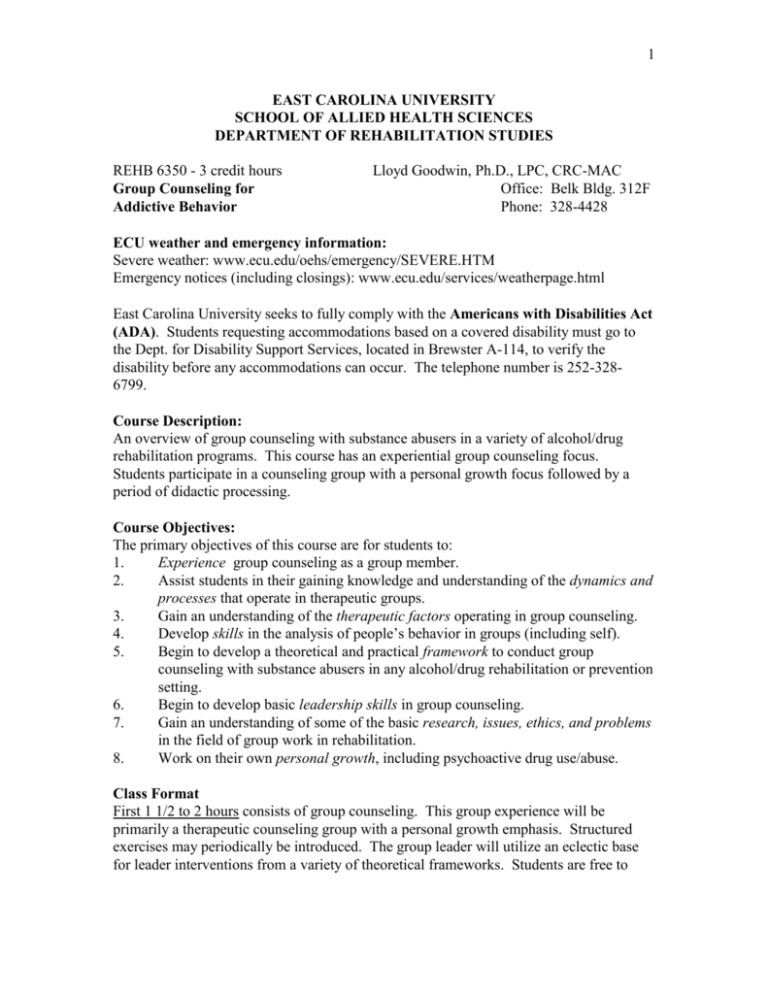
1 EAST CAROLINA UNIVERSITY SCHOOL OF ALLIED HEALTH SCIENCES DEPARTMENT OF REHABILITATION STUDIES REHB 6350 - 3 credit hours Group Counseling for Addictive Behavior Lloyd Goodwin, Ph.D., LPC, CRC-MAC Office: Belk Bldg. 312F Phone: 328-4428 ECU weather and emergency information: Severe weather: www.ecu.edu/oehs/emergency/SEVERE.HTM Emergency notices (including closings): www.ecu.edu/services/weatherpage.html East Carolina University seeks to fully comply with the Americans with Disabilities Act (ADA). Students requesting accommodations based on a covered disability must go to the Dept. for Disability Support Services, located in Brewster A-114, to verify the disability before any accommodations can occur. The telephone number is 252-3286799. Course Description: An overview of group counseling with substance abusers in a variety of alcohol/drug rehabilitation programs. This course has an experiential group counseling focus. Students participate in a counseling group with a personal growth focus followed by a period of didactic processing. Course Objectives: The primary objectives of this course are for students to: 1. Experience group counseling as a group member. 2. Assist students in their gaining knowledge and understanding of the dynamics and processes that operate in therapeutic groups. 3. Gain an understanding of the therapeutic factors operating in group counseling. 4. Develop skills in the analysis of people’s behavior in groups (including self). 5. Begin to develop a theoretical and practical framework to conduct group counseling with substance abusers in any alcohol/drug rehabilitation or prevention setting. 6. Begin to develop basic leadership skills in group counseling. 7. Gain an understanding of some of the basic research, issues, ethics, and problems in the field of group work in rehabilitation. 8. Work on their own personal growth, including psychoactive drug use/abuse. Class Format First 1 1/2 to 2 hours consists of group counseling. This group experience will be primarily a therapeutic counseling group with a personal growth emphasis. Structured exercises may periodically be introduced. The group leader will utilize an eclectic base for leader interventions from a variety of theoretical frameworks. Students are free to 2 participate in the counseling group at whatever level of involvement they feel comfortable. Revised Spring, 2005 Last hour will be devoted to discussing what transpired during the group counseling session. Discussion will focus primarily on group dynamics, personal reactions, insights, and leader interventions. Students will be expected to relate their readings to the discussion. Course Requirements: 1. Readings: The reading of the texts and other assigned readings. 2. Attendance: Attendance and participation in all of the group activities and subsequent discussion are required. Absences of three (two in summer session) or more classes will adversely affect the student’s grade. 3. Journal/Log: Students are to keep a journal of their perceptions, feelings, reactions, and personal insights. Also, students provide an analysis of the group dynamics and process of each group session to be turned in the following session. Each journal entry is to include two: Observations: Briefly describe two events that occurred at that group meeting. Inferences: Speculate on possible explanations for each event’s occurrence. Why do you think they did that? Include references from your readings as well as provide your own insights. Personal Reactions: When this event occurred what was your personal reaction? What did you think? What did you feel? Interventions - What was the intervention, if any? What did you do? What did the other group members or leader do about it? *Put date of group session on each log entry. 4. 5. Chapter Reaction Papers: A brief (approximately 1 or 2 typed pages) reaction paper to each of the chapters in the textbook I Never Knew I Had A Choice by Corey and Corey. One reaction paper is to be turned in each meeting starting with the second meeting. Individualized project optional. Each student who wants to receive extra credit in this course will contract with the professor to do an individual project that relates to this course. Term papers or book reports must be 6-10 pages in length and is due on the last group session. All journal/logs, reaction papers to I Never Knew I Had a Choice, and term papers are due no later than the last group session. Evaluation/Grades: 3 1. Attendance and participation in all 15 (11 in summer session) of the group meetings and discussion is expected. Because of the experiential nature of this course, and the written assignments (Journal/log entries) generated from these experiences, the following criteria have been established: A= Optional individualized project (e.g. term paper, starting and coleading a group, etc.) See instructor before proceeding with this project. Up to one absence. B= Successful completion of items 1-2 and up to one absence. B= Successful completion of items 1-2, individualized project, and two absences. C= Successful completion of items 1-2 and two (one in summer session) absences. F= Three (two in summer session) or more absences. OR 2. The journal/log will be evaluated on a satisfactory/unsatisfactory basis. 3. The chapter reaction papers to I Never Knew I Had A Choice, by Corey, will be evaluated on a satisfactory/unsatisfactory basis. 4. The individualized project is optional. The student has the option of earning an A by doing an individualized project (e.g., term paper, starting and running a group, etc.). Projects will not be accepted after last class meeting. 5. No incompletes will be given for this class. Texts (Required) 1. Corey, M.S. & Corey, G. (2002) Groups: Process and Practice. 6th ed. Pacific Grove, CA: Brooks/Cole. 2. Corey, G. (2002). I Never Knew I Had A Choice. 7th ed. Pacific Grove, CA: Brooks/Cole. 3. Supplemental Reading Packet and other assigned readings. NCADI 800-729-6686 Texts (Recommended) 1. Corey, G., Corey, M.S. Callanan, P.J. & Russell, J.M. (1992). Group techniques. (2nd ed.) Monterey, CA: Brooks/Cole. 4 2. 3. 4. 5. 6. 7. *8. 9. 10. 11. 12. 13. 14. *15. 16. *17. 18. 19. 20. 21. Corey, M.S. & Corey, G. (2002). Groups: Process and Practice. (7th ed.) Monterey, CA: Brooks/Cole. Corey, G. (Latest edition). Theory and Practice of Group Counseling. Pacific Grove, CA: Brooks/Cole. Dryer, W.W. & Vriend, Jr. (1980). Group Counseling for Personal mastery: Everything you need to know to lead any group in any setting. New York: Sovereign Books. Dossick, J. & Shea, E. - Creative therapy: Exercises for Groups, 1988. - Creative Therapy II: 52 More Exercises for Groups, 1990. - Creative Therapy III; 52 More Exercises for Groups, 1995. Elder, I.R. (1990). Conducting group therapy with addicts: A guidebook for professionals. Blue Ridge Summit, PA: TAB Books. Flemming, M. (1990). Conducting support groups for students affected by chemical dependence: A guide for educators and other professionals. Minneapolis, MN: Johnson Institute. Flores, P.J. (1997). Group psychotherapy with addicted populations (2nd ed.) N.Y.: The Haworth Press. Gazda, G.M. (1989). Group counseling: A developmental approach. 4th edition. Boston: Allyn and Bacon. Goodwin, L.R., Jr. (2002). The button therapy book: How to work on your buttons and the button-Pushers in your life. British Columbia, Canada: Trafford Publishing. Hardy, R.E. & Cull, J.G. (Eds). (1974). Group counseling and therapy techniques in special settings. Springfield, IL: Charles C. Thomas. Jourard, S.M. (1971). The transparent self. Revised edition. New York: D. Van Nostrand Co. (Soft). Kaplan, H.I. & Sadock, B.J. (Eds.) (1993). Comprehensive group psychotherapy. (3rd ed.). Baltimore, MD: Williams & Wilkins. Lasky, R.G. & Dellorto, A.E. (1979). Group Counseling and Physical Disability. North Scituate, MA: Duxbury Press. Levine, B. & Gallogly, V. (1985). Group therapy with alcoholics: Outpatient and inpatient approaches. Beverly Hills, CA: SAGE. McKay, M. & Paleg, K. (Eds.) (1992). Focal group psychotherapy. Oakland, CA: New Harbinger Publications. Monti, P.M., Abrams, D.B., Kadden, R.M. & Conney, N.L. (1989). Treating alcohol dependence: A coping skills training guide. NY: Guilford Press. Rogers, R. L. & McMillin, C.S. (1989). The healing bond: Treating addictions in groups. NY: W.W. Norton & Co. Seligman, M. (1982). Group psychotherapy and counseling with special populations. Baltimore, MD: University Park Press. Seligman, M. (ed.) (1977). Group counseling and group psychotherapy with rehabilitation clients. Springfield, IL: Charles C. Thomas. Silverman, P.E. (1980). Mutual help groups: Organization and development. Beverly Hills, CA: SAGE. 5 22. 23. 25. 26. Vannicelli, M. (1992). Removing the roadblocks: Group psychotherapy with substance abusers and family members. NY: The Guilford Press. Vannicelli, M. (1989). Group psychotherapy with adult children of alcoholics: Treatment techniques and countertransference considerations. NY: The Guilford Press. Vinogradov, S. & Yalom, I.D. (1989) A concise Guide to Group Psychotherapy, Washington, D.C.: American Psychiatric Press. Yalom, I.D. (1995). The theory and practice of group psychotherapy. (4th edition. NY: Basic Books. 6 COURSE OUTLINE REHB 6350 Group Counseling Dr. Lloyd Goodwin I. INTRODUCTION TO COURSE A. Ground rules for experiential activities B. Getting acquainted exercise C. Fears, apprehensions and misconceptions about counseling groups II. PERSPECTIVE ON GROUP PROCESS AND PRACTICE A. Types of groups including Professional and Mutual-help groups B. Group Counseling theories (e.g. Transactional Analysis, Gestalt, behavioral, etc.) C. Group leadership and co-leadership ASSIGNED READINGS 1. Corey and Corey text, Chapter 1 III. GUIDELINES FOR ETHICAL AND PROFESSIONAL PRACTICE FOR GROUP LEADERS A. Guidelines for developing group leadership competence B. Issues in group membership C. Moral and legal standards ASSIGNED READINGS 1. Corey and Corey text, Chapter 2 IV. PREGROUP ISSUES; FORMATION OF A GROUP A. Agency/Program considerations B. Getting members C. Group composition D. The uses of a pregroup meeting or the initial session E. Preparing for groups ASSIGNED READINGS 1. Corey and Corey text, Chapter 3 2. Dryer, W.W. and Vriend, J. (1980). Group Counseling For Personal Mastery: Everything You Need to Know to Lead Any Group In Any Setting. New York: Sovereign Books. Twenty Basic Assumptions Underlying Effective Group Counseling As Defined Above:, pp. 46-61. And Chapter 9 “Your Subsequent Group Sessions”: pp. 318-235. V. THE INITIAL STAGES OF A GROUP A. How to get the most from a group experience 7 B. C. D. E. 1. Guidelines for members including ground rules Group-process concepts at the initial stage 1. Group cohesion 2. Group norms Group characteristics of the initial stage The role of leaders and members in creating trust and assisting members in defining personal goals Leader skills in opening and closing group sessions. ASSIGNED READINGS 1. Corey and Corey text, Chapter 4 VI. THE TRANSITION STAGE OF A GROUP A. Characteristic of the transition stage B. Problem behaviors and difficult group members C. Dealing with transference and countertransference D. Identifying problems with a group ASSIGNED READINGS 1. Corey and Corey text, Chapter 5 VII. THE WORKING STAGE OF A GROUP A. Characteristics of the working stage B. Therapeutic factors that operate in groups ASSIGNED READINGS 1. Corey and Corey text, Chapter 6 VIII. ENDING A GROUP AND POST-GROUP ISSUES A. The tasks of the final stage: consolidation of learnings B. Termination of the group experience C. Evaluation of the group experience D. Follow-up ASSIGNED READINGS 1. Corey and Corey text, Chapter 7 XI. SUMMARY OF STAGES OF GROUP DEVELOPMENT A. Points to remember: Summary ASSIGNED READINGS 1. Corey and Corey, Chapter 8 8 X. GROUP WORK WITH SOME SPECIAL GROUPS A. Group for children B. Group for adolescents C. Groups for Adults D. Groups for the elderly ASSIGNED READINGS 1. Corey and Corey text, Chapters 9 - 12
